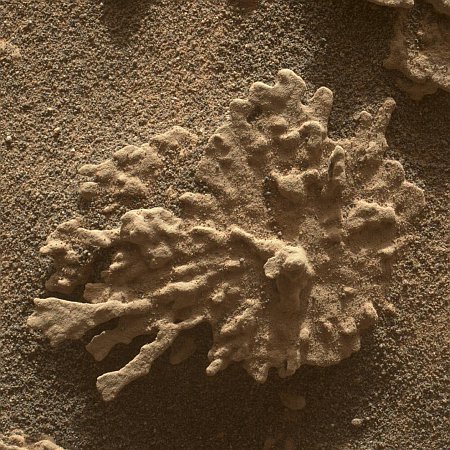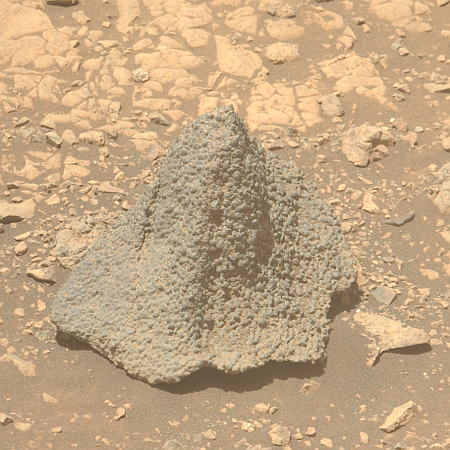Strange rocks on Mars
Time for two cool images, from two different craters separated by thousands of miles on Mars! The first image to the right, cropped, reduced, and sharpened to post here, was taken on July 24, 2025 by the Mars Hand Lens Imager (MAHLI) at the end of the robot arm of Mars rover Curiosity, and shows a really strange rock formation that resembles a piece of coral on Earth.
Curiosity has found many small features like this one, which formed billions of years ago when liquid water still existed on Mars [in this region]. Water carried dissolved minerals into rock cracks and later dried, leaving the hardened minerals behind. Eons of sandblasting by the wind wore away the surrounding rock, producing unique shapes.
The second image, cropped, reduced, and sharpened to post here, was taken on August 5, 2025 by the left high resolution camera on the rover Perseverance. It shows what appears what geologists call a “float rock”, something that was created geologically somewhere else and transported to this location later.
In this case the rock appears lavalike in nature. Since Perseverance is exploring the exterior rim of Jezero Crater, we could be looking at the impact melt created when the bolide hit the ground to create the crater. Material would be instantly melted as well as flung outward as ejecta, with this strangely shaped rock an example.
The problem with this theory however is that the rock appears to have solidified well before it hit the ground at this location. Its shape also suggests it solidified within a crack, thus molding it to this shape, with its top once at the bottom, the lava flowing downward. The mystery then is how it ended up as we see it, upside down and exposed.
On Christmas Eve 1968 three Americans became the first humans to visit another world. What they did to celebrate was unexpected and profound, and will be remembered throughout all human history. Genesis: the Story of Apollo 8, Robert Zimmerman's classic history of humanity's first journey to another world, tells that story, and it is now available as both an ebook and an audiobook, both with a foreword by Valerie Anders and a new introduction by Robert Zimmerman.
The print edition can be purchased at Amazon or from any other book seller. If you want an autographed copy the price is $60 for the hardback and $45 for the paperback, plus $8 shipping for each. Go here for purchasing details. The ebook is available everywhere for $5.99 (before discount) at amazon, or direct from my ebook publisher, ebookit. If you buy it from ebookit you don't support the big tech companies and the author gets a bigger cut much sooner.
The audiobook is also available at all these vendors, and is also free with a 30-day trial membership to Audible.
"Not simply about one mission, [Genesis] is also the history of America's quest for the moon... Zimmerman has done a masterful job of tying disparate events together into a solid account of one of America's greatest human triumphs."--San Antonio Express-News
Time for two cool images, from two different craters separated by thousands of miles on Mars! The first image to the right, cropped, reduced, and sharpened to post here, was taken on July 24, 2025 by the Mars Hand Lens Imager (MAHLI) at the end of the robot arm of Mars rover Curiosity, and shows a really strange rock formation that resembles a piece of coral on Earth.
Curiosity has found many small features like this one, which formed billions of years ago when liquid water still existed on Mars [in this region]. Water carried dissolved minerals into rock cracks and later dried, leaving the hardened minerals behind. Eons of sandblasting by the wind wore away the surrounding rock, producing unique shapes.
The second image, cropped, reduced, and sharpened to post here, was taken on August 5, 2025 by the left high resolution camera on the rover Perseverance. It shows what appears what geologists call a “float rock”, something that was created geologically somewhere else and transported to this location later.
In this case the rock appears lavalike in nature. Since Perseverance is exploring the exterior rim of Jezero Crater, we could be looking at the impact melt created when the bolide hit the ground to create the crater. Material would be instantly melted as well as flung outward as ejecta, with this strangely shaped rock an example.
The problem with this theory however is that the rock appears to have solidified well before it hit the ground at this location. Its shape also suggests it solidified within a crack, thus molding it to this shape, with its top once at the bottom, the lava flowing downward. The mystery then is how it ended up as we see it, upside down and exposed.
On Christmas Eve 1968 three Americans became the first humans to visit another world. What they did to celebrate was unexpected and profound, and will be remembered throughout all human history. Genesis: the Story of Apollo 8, Robert Zimmerman's classic history of humanity's first journey to another world, tells that story, and it is now available as both an ebook and an audiobook, both with a foreword by Valerie Anders and a new introduction by Robert Zimmerman.
The print edition can be purchased at Amazon or from any other book seller. If you want an autographed copy the price is $60 for the hardback and $45 for the paperback, plus $8 shipping for each. Go here for purchasing details. The ebook is available everywhere for $5.99 (before discount) at amazon, or direct from my ebook publisher, ebookit. If you buy it from ebookit you don't support the big tech companies and the author gets a bigger cut much sooner.
The audiobook is also available at all these vendors, and is also free with a 30-day trial membership to Audible.
"Not simply about one mission, [Genesis] is also the history of America's quest for the moon... Zimmerman has done a masterful job of tying disparate events together into a solid account of one of America's greatest human triumphs."--San Antonio Express-News




I have no clue regarding the second photo, but I literally have extremely similar fossils of corals to the first photo. Mine have more of the matrix still surrounding the fossil itself, but they never had millions/billions of years of gentle sand blasting to expose the goodies…
I’m a rank amateur, and its a very alien environment, but heck! That looks organic in origen to me!
The Perseverance rock in NO WAY appears “lava like”. It’s an agglomeration of spherules. There’s a type of volcanic rock known as a “lapilli tuff”. Lapilli are small, often spherical clasts. My guess is that it is a
Lapilli tuff- a product of explosive volcanism, not effusive volcanism.
Bill Farrand: Well, you for sure know more about geology than me. I play a geologist for fun. You do it for real.
How would this rock have formed from explosive volcanism? And if so, would that have been the method for transporting it here?
The top photo might also be caused by a lightning strike that has melted sand (called fulgurites). Then the surrounding material is blown away.
@Don C, I have a couple of fulgurites ( I didn’t know that term, thank you!) from the desert in Tunisia… They are certainly a bit “branchy” for want of a better term, but look no where near as organic looking as this mars rock. It’s an alien world, and we know almost nothing about how it works or has worked, but if fossil hunting it is a rock which would have caught my eye. You are probably nearer the mark, but it’s fun to speculate!
I dunno… there’s a famous scene in Jurassic Park that more likely explains the second photo.
Robert, sorry for the delayed response… the rock that I interpreted as a lapilli tuff was probably thrown out by an impact. You can go way back to when Opportunity drove out of it’s Eagle crater landing spot and found “Bounce Rock” which had a Shergottite composition and was clearly ejected from a distant crater.